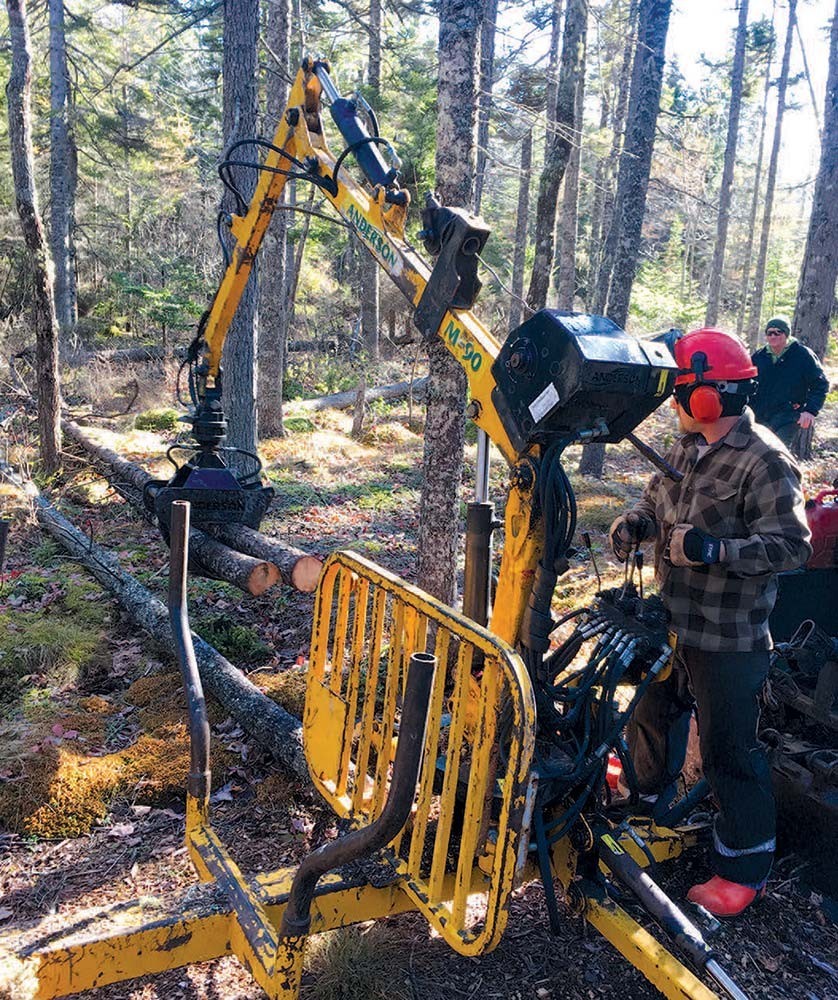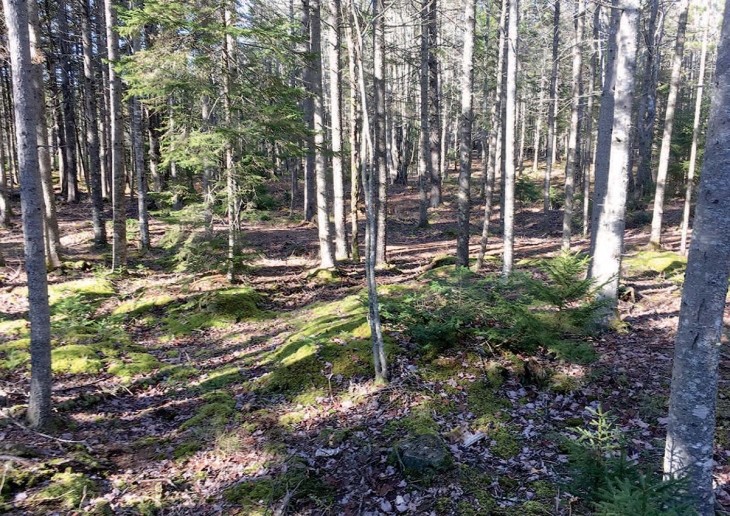
Dave Ireland is showing off his woods. Well, not his woods, exactly. We’re walking along a dirt road on Mount Desert Island. The waves and the brisk coastal wind whisper in the distance.
On the right side is woods he has worked in. On the left, one he hasn’t. The difference is striking.
To the right the forest is manicured. No blowdowns. No brush. Trees thinned. Lower branches on the spruces trimmed. A trail of wood chips flows through the luxuriant bed of moss on the forest floor.
To the left is a thicket of older and younger spruces, firs, red maples, and alder – laced with a tangle of gray, dead spruces and fallen branches.
Ireland has worked in the woods since he was a teen growing up in Howland. His dad and granddad were loggers. He started logging with a cable skidder full time after graduating from high school in 1986 and in the late 1990s, moved into mechanical harvesting.
Now he does a different kind of logging.
“My average client is interested in aesthetics. No timber value. Just cleanup,” he explained.
The coastal properties where he works are relatively small compared to many timber operations – the largest is approximately 75 acres. The work is varied, and customized to each landowner’s interests. Ireland and his team build walking and biking trails, sometimes surfacing them with wood chips created from slash. The trails are wide enough to serve as access routes in case of fire. They also remove blowdowns, thus reducing the volume of potential wildfire fuel. And they thin overstocked stands.
Some people might say this work isn’t logging at all. But there is a word for it, or words – “woodscaping” or “forestscaping.” Ireland likes “forestscaping” better. He feels it better reflects the scope of what he does.
Forestscaping focuses less on timber and more on the non-economic goals landowners have for their land: aesthetics, especially, and often recreational trails and wildlife habitat. As with many activities to shape the woods, there can be a tradeoff between priorities; clearing brush may improve recreational experiences, but come at the cost of midstory and understory habitat. Removing shrubs, snags, and woody debris can eliminate protective cover and reduce breeding opportunities for many species of native wildlife, from amphibians to songbirds. Forestscaping can also reduce invertebrate abundance and diversity.
To help balance the tradeoff, Ireland’s crew frequently installs birdhouses, clears out invasives, and creates wildlife dens. The dens are built by laying up to four 6- to 10-inch logs parallel at least a foot to 18 inches apart, topped by a second layer of logs perpendicular to the first, then adding limbs to a height of at least four feet and topping with conifer branches.
Morten Moesswilde, a Maine Forest Service district forester whose area includes several mid-coast counties, sees long-term benefits to forestcaping. “Even with an emphasis on aesthetics, it can really help the future growth and composition of the forest,” he said, “especially in areas that have been high-graded in the past.”
Forestscaping can function “like one of several types of ‘improvement’ thinning,” explained Moesswilde. Benefits can include encouraging longer-lived and/or later-successional species or trees with better form, as well as allowing trees to build stronger crowns.
“At the stand level, it can also just keep a few individuals of an uncommon species in the stand, maintaining species diversity, or at least a seed source for future regeneration of that species,” Moesswilde added. “That’s especially true in high-graded stands, where a particular species might have been targeted for harvest.” If, for instance, a logging operation took out almost all the sugar maples, “finding, protecting, or even thinning around even a handful of sugar maples that got missed might make a big difference in the long run, aesthetically as well as ecologically.”
Also, careful thinning during a forestscaping project “can help build a structurally diverse” multilayered canopy with bigger crowns and deeper root systems, Moesswilde said. “That could in turn lead to an increase in growth rates so that you get bigger trees faster (which has wildlife benefit as well as timber). Of course if you encourage the best-quality stems with potential as valuable logs, that’s a future economic benefit as well.”
Ireland’s company is called Woodland Restoration, Inc. He works on and around Mount Desert Island, including on smaller islands, and charges by the hour, $75 to $150, depending on how many people are on the crew.
He has been doing this type of work for 10 years. He was riding a feller buncher in northern Maine when he decided he wanted to do something different. The economics of large-scale harvesting were changing – fuel prices were skyrocketing and it was getting harder to sell logs. “There was an emphasis on large volumes of wood. I wasn’t really into that,” Ireland said.
He sold his feller buncher and bought a Forcat (today called Oxtrac) mini-track skidder. “Everybody told me I was crazy when I bought that little skidder,” he remarked. “It fits in the back of a pickup truck.”
Ireland began pitching his services to landowners with smaller parcels who were willing to pay out-of-pocket to improve the appearance of their woods.
His big break came when he was hired by Rick Smith, a founder of the Hancock Timber Resource Group and Forest Systems LLC. Ireland cleaned up blowdowns on Smith’s property on Latty Cove Road in Tremont. Then he created a walking trail. Three months later, Smith threw a party to showcase the work. “I ended up getting work from everybody on that road,” Ireland said. Half a dozen of those landowners have become regular clients.
For Smith, the “overriding objective” of Ireland’s work for him “is to get the fuel load down and get the forest health up.” Smith worries that as coastal spruce-fir forests on Mount Desert Island and surrounding islands collapse into entangled dry masses, they could create conditions for another major fire like the one that ravaged more than 17,000 acres on the island in 1947.
Ireland works pretty much year-round. Summer is especially busy. He employs a two-, sometimes three-person, crew and maintains two mini-skidders with rubber tracks, a brace of mini-forwarders that can be towed by the skidders, a Kubota with a dump body, and two tow-behind chippers.
Although this may seem like a lot of overhead to carry, Ireland points out that all of his equipment together cost far less than the $243,000 he paid for his first feller-buncher, and several times less than what he would pay for a new machine now. The relatively lightweight equipment is not only cheaper, it’s better suited for working on soft ground, and easier to transport between sites.
On a brisk November day, Ben Dow, Ireland’s son-in-law, is removing recent blowdowns and deadfall from a trail through the spruce forest off Latty Cove Road, using a mini-forwarder hitched to the Forcat.
He deftly grabs the cut-off stems with the claw of the forwarder, pulls them over to the trail, cuts them to length with a chainsaw, and then twirls the pieces into the trailer to be hauled out for chipping. For a longer reach he uses a cable winch. The techniques, and the equipment, said Dow, are important because they are often working in boggy areas. To demonstrate, he stabs a 4-foot fiberglass measuring rod into the ground, sinking it to within 3 inches of the end. Standard logging equipment would really make a mess of things. The little Forcat and forwarder don’t.
Woodland Restoration occasionally harvests some merchantable timber, but not much. On Smith’s property, some of the spruce sawlogs were sawn into timbers and lumber used in a stunning post-and-beam barn.
“I do think more timber should be harvested and more management should happen on these lots down here,” Ireland said. However, wood markets have declined, especially for low-grade wood. And making money from stumpage is just not on his clients’ list of priorities. Many of his clients are paying tens of thousands of dollars in property taxes each year; a few hundred dollars for logs isn’t a major consideration.
It’s a niche business, he acknowledged. “That type of clientele is what you’d have to target to build a business like mine. You’ve got to hit those coastal towns where the real estate is worth a lot of money.”
Si Balch is a former industrial forester and New England Forestry Foundation forest director (and Northern Woodlands board member) who now works with forestland owners on Maine’s midcoast. According to Balch, the demand for forestcaping is growing. There is “more demand than people to do it,” Balch said. And, a “big variety of players, from little farm tractors, specialized equipment, horses, normal skidders, fully mechanized jobs, and large firms.”
Successful contractors not only have to have the experience, expertise, and equipment to do the job, continued Balch, but good people skills. The key to success is, “being willing to listen.”
Another key requirement: a high tolerance for hard work.
“You’ve got to have the right equipment, but 90 percent of it is physical labor,” said Ireland. “All the trees are harvested by hand, the slash is fed into the chipper by hand.”
Over the years, Ireland has broadened his services to include traditional landscaping tasks, such as digging ponds, building stone and timber bridges, and even mowing lawns. These days, he estimates, a full half of his work involves these more traditional landscaping jobs. “Excavation is a lot easier than dragging brush to a chipper,” and easier on an older guy’s knees, he added wryly.
Forestscaping or Forestry for Birds?
Tangled and multilayered forests provide important habitat for many songbirds, including some species at risk in the Northeast. Careful planning with a county/district forester or wildlife extension specialist can enable landowners to achieve both aesthetic and conservation objectives on the same property. Open or semi-open understories around homes, created by forestscaping, can grade into more dense structure in deeper parts of the woods. Or thinning can be done in irregular patches to add visual interest and habitat complexity to a property. Whether creating sightlines beneath the canopy or dense cover for shrub-nesting warblers, landowners can be certain that – compared to lawns – tree cover delivers more value to birds every day of the week.


